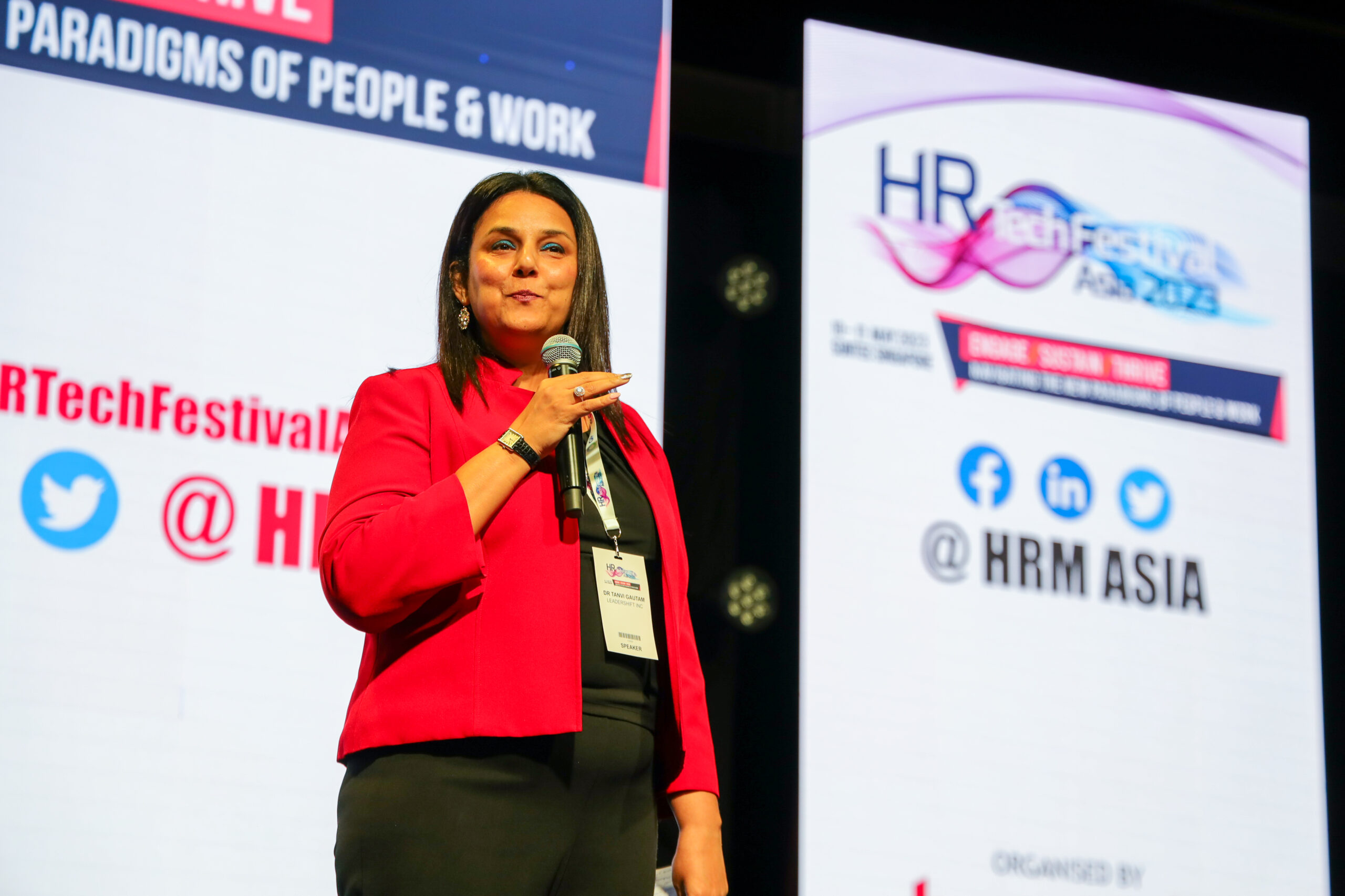Crafting narratives of change: A human-centric approach
- Shawn Liew

“If AI is becoming more human, we need to make sure that organisations don’t become more machine like and instead focus on creating a human-centric workplace.” – Dr Tanvi Gautam, HR Influencer, Keynote Speaker, Transformational Leadership Expert, and author of the upcoming book – Deep Collaboration: 5 Crucial Conversations To Accelerate Team Performance Across Silos
While generative AI has continued to permeate into all facts of life, including work, it is perhaps fair to suggest that the technology has raised more questions than answers. Will millions of jobs be replaced at the same time as new roles are being created, and how will it redefine the role of people in the workplace?
Driven partly by the rise of AI and the accompanying shift needed in capabilities, the workplace is transforming in fundamental ways, said Dr Tanvi Gautam, HR Influencer, Keynote Speaker, Transformational Leadership Expert and author of the upcoming book – “Deep Collaboration: 5 Crucial Conversations To Accelerate Team Performance Across Silos.”
Speaking with HRM Magazine Asia, she added, “If AI is becoming more human, we need to make sure that organisations don’t become more machine like and instead focus on creating a human-centric workplace that priorities skills such as creativity and strategic thinking, empathy, and we start to pay attention to deeply human attributes of interaction such as relational and somatic intelligence skills as well as storytelling and narrative building capabilities.”
Many employees have also emerged from the pandemic reevaluating the priorities in their lives and pondering why they do what they do. This heightened awareness, said Dr Tanvi, is even more evident in younger employees who demand that employers act on issues such as sustainability, purpose, and inclusivity. She also raised concerns on the approach some companies are taking on these issues. “Organisations who continue to pay lip service 0and engage in green-washing or pink-washing the agenda will face increasing pressure to declare their activities beyond slogans and campaigns.”
Organisations will also need to redefine how they generate value by breaking down silos and leverage a networks-based, eco-systems approach. “The ability to collaborate across sectors and industry lines will become a core competitive advantage,” Dr Tanvi explained. “However, organisations that can’t even get collaboration going across company lines will find it hard to get it going across industry lines. This has meant that organisations now need to seriously look at bolstering the collaborative capabilities of their people.”
Embarking on the culture transformation journey with your people
As collective consciousness evolves and employer-employee relationships are being redefined amidst technological advancements, organisations must continuously re-evaluate how their culture suits an ever-changing context.
Before embarking on their culture transformation journey however, organisations must recognise that culture transformation is an ongoing, adaptive, and collaborative process marked by significant milestones, as opposed to a linear journey with a defined endpoint. Transformation is a journey, not a destination.
Instead of working only on a fixed blueprint or a predefined timeline, Dr Tanvi advised organisations to cultivate an “emergent and evolutionary relationship” alongside their cultural transformation.
Drawing an analogy to gardening, she described, “Just as a garden requires regular care based on seasons, weed control, and soil enrichment, culture change thrives when approached with organic metaphors rooted in nature, rather than rigid industrial-age prescriptions.”
The next critical factor for successful culture transformation is an obvious one, she noted. While many organisations have undergone structural changes, desired outcomes continue to elude them because they are failing to change the mindsets and attitudes of people.
“Merely launching campaigns and adopting new ways of working will yield limited results, leading to the all-too-common statistic that 70% of change management efforts fail,” Dr Tanvi said. “I often advise my clients to contemplate the impact of an initiative, not just on your organisation, but also on your personal self as a human being and professional skill set. Embrace the collective benefits it will bring to all involved for the initiative to develop deeper roots”.
To demonstrate empathy toward employees, organisations must craft a compelling narrative around culture change. Powerful and inspiring storytelling encourages employee buy-in and fosters a sense of connection to the desired change. This prepares employees for what lies ahead, align the individual purpose with the role purpose, and link them to the overarching organisational purpose.
Dr Tanvi elaborated, “By skilfully crafting the narrative of change, we greatly enhance the likelihood of individuals going above and beyond their existing efforts to facilitate the transformation. While many companies focus on presenting charts and graphs to address the issue, we must concurrently address how the human brain processes change as a threat as well as the strain of the change on our nervous systems. Neuroscience and somatic intelligence have a role to play in the success of change processes” she noted.
Breaking down silos to enhance organisational performance
For organisations looking to reinvent their business models in an age of technology transformation, working in silos and collaboration are incongruous and contradictory concepts.
However, are organisations doing enough support collaboration in the workplace? “Today, in many companies, even if there is a desire to collaborate, rewards and appraisals are set up to serve individuals and not collective goals,” Dr Tanvi observed. “A jadedness may even hang in the air in such cultures where attempts at collaboration in the past have gone wrong due to the excessive focus on the structure of change and not the humanity and emotion of change.”
The conversations that organisations have with employees play a key role in determining the quality of collaboration, as Dr Tanvi explores in her upcoming book, “Deep Collaboration: 5 Crucial Conversations To Accelerate Team Performance Across Silos.” “Shallow conversations lead to shallow collaborations and create a culture where people are busy protecting their turf and end up playing passive-aggressive games that serve no one,” she highlighted.
“I find that once teams engage in the five conversations of deep collaboration, they approach their goals with a renewed sense of purpose and engagement. It is through conversations that people feel that they are seen, heard, understood, accepted and aligned.”
To move beyond superficial markers of collaboration to deep collaboration, organisations must learn to create a third identity beyond traditional functional areas or domains. “This in turn requires us to create that connection and commitment to a collective future that both inspires us to do more and be more, as well as cultivate a nuanced understanding of domains of expertise beyond our own” Dr Tanvi said.
“The days of the vertical, deep-diving expert are over, and we need leaders to have the ability to span boundaries,” Dr Tanvi suggested. “HR has to learn to speak technology, leaders in marketing have to learn to speak HR, and so on.”
READ MORE: Coping with change management plans without burning out
Leaders who will create thriving workplaces must begin with self-awareness, self-leadership, and a willingness to be a life-long learner; these, along with boundary-spanning skills, will all be key traits for the leaders of the future.
But perhaps most important of all, leaders need to demonstrate empathy and humility in recognising the work is a means to an end and not an end in itself. The focus on people and a humancentric approach, it would appear, is non-negotiable for long-term success.
“Helping their teams manage and integrate the demands of being human with the demands of the workplace will be a crucial and supportive skill set of leaders of sustainable growth,” Dr Tanvi concluded.






